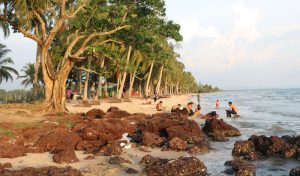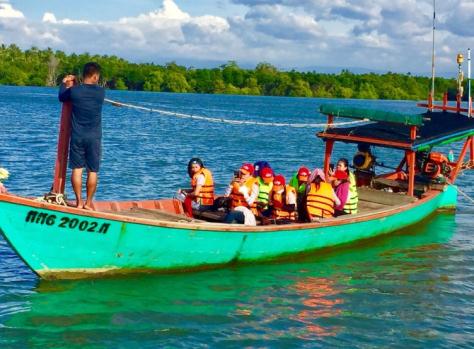 Drive about 165 km from Phnom Penh on National Road No. 4, turn right to continue for another 17 km on National Road No. 48, arrive at an intersection, and then turn left onto the red rock commune road to the Chroy Svay fishing community. The place is very attractive for local, national and international visitors because of its beautiful seaside and mangrove forest, enriched with many varieties of marine fishery resources such as shrimp, crab, snails and fish. There are around 2,000 household members in the Chroy Svay community fishery. Most of them are smallholder fishers.
Drive about 165 km from Phnom Penh on National Road No. 4, turn right to continue for another 17 km on National Road No. 48, arrive at an intersection, and then turn left onto the red rock commune road to the Chroy Svay fishing community. The place is very attractive for local, national and international visitors because of its beautiful seaside and mangrove forest, enriched with many varieties of marine fishery resources such as shrimp, crab, snails and fish. There are around 2,000 household members in the Chroy Svay community fishery. Most of them are smallholder fishers.
“Currently, the women in my community are very busy to earn extra income through seafood processing activities. I notice that there is a remarkable increase in the number of visitors coming to our community for eco-tourism, contrib-uting to increased purchase of our community products and eco-tourism services. Thanks to Morodok for facilitation and support for the strengthening of our community fishery, establishment of eco-tourism, and especially support to seafood processing and marketing. Previously only men who caught fish with their fishing nets could make income selling their fresh fish directly to wholesalers at nonnegotiable prices. Today my community could sell both fresh and processed seafood products, not only to visitors, but also to wholesalers coming to our villages and buying the products at a better price” said Mr. Kun Hok, a leader of the Chroy Svay Community Fishery.
 Mr. Kun Hok added that the Chroy Svay Eco-Tourism project also substantially contributed to increased income for his community members. The visitors can be individuals, groups, companies or organizations. The visitors can visit the mangrove forest, visit the seaside, swim, catch crabs or snails, and go fishing. The beach is close to the homestay so they can see the beautiful sunrise in the early morning and sunset in the evening. They can also order a wonderful breakfast, lunch and dinner with Khmer dishes from the community sellers.
Mr. Kun Hok added that the Chroy Svay Eco-Tourism project also substantially contributed to increased income for his community members. The visitors can be individuals, groups, companies or organizations. The visitors can visit the mangrove forest, visit the seaside, swim, catch crabs or snails, and go fishing. The beach is close to the homestay so they can see the beautiful sunrise in the early morning and sunset in the evening. They can also order a wonderful breakfast, lunch and dinner with Khmer dishes from the community sellers.
The design of Morodok’s program was based on a needs assessment with local communities to make sure that the intervention is highly responsive to the identified needs. Morodok’s program pooled its efforts to improve the co-management of fishery resources and increase opportunities for better livelihoods through increased access to adequate skills, markets and financial services.

